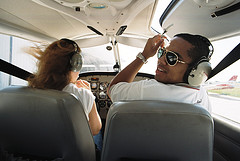How To Become a Light Sport Aircraft Pilot
Have you dreamed for years of becoming a pilot? If so, you're in luck, because the soaring popularity of light sport aircraft means that your dream has been transformed from "pie-in-the sky" to "pilot (you)-in-the-sky!Qualifying for a light sport aircraft pilot's license will take you less than half the time of qualifying for a private pilot's license. Not only that, it will enable you to operate an aircraft you can actually afford to own! Some light sport aircraft models retail for not much more than a loaded SUV, and get better mileage (up to 20mpg.) They are allowed to reach speeds of 220 km/h, or 138 MPH, and altitudes of no more than 10,000 feet.
Being a light aircraft pilot means that you and a passenger can fly when you want, except at night, to any airports you want (if your license has additional privileges), bringing along one passenger. You'll no longer be limited to the seldom-met schedules and inconvenient routes of the commercial airlines. You can skip those long lines at the airport security checkpoints, and as long as your plane's gross takeoff weight doesn't exceed 1320 pounds, you can carry as much luggage as you need!
What sort of training is involved in getting a light sport aircraft pilot's license?
- You must be at least 16 to begin training in any of the categories of light sport aircraft (excluding gliders, when you must be 14).
- You must be at least 17 (16 in the case of gliders) before you can test for your light sport aircraft pilot's license.
- In the US, you must have a current driver's license, which serves as your medical certification. You must also show that you are in good overall health and not using any medications which could impair your ability to pilot the aircraft.
- You must (in the US) be able to speak, read, understand, and write English. While US citizenship is not required, your FAA flight certification will be invalid in any other country.
- You'll need a student pilot's license, available at no charge from any FAA Flight Standards District Office.
- You may qualify to take the light sport aircraft pilot certification exam with as little as twenty hours (fifteen with an instructor and five as a solo pilot) of flight time.
- You'll have to pass both a written and practical test.
How much will qualifying as a light sport aircraft pilot cost?
Expect to spend between $3000 and $3500 to qualify for your light sport aircraft pilot's license, which is about half of what a private pilot's license would set you back.
Finally, every hour you spent piloting a light sport aircraft can be applied to future training for a private pilot's license if you decide to move on to a larger aircraft. So why not get your head out of the clouds and become a light sport aircraft pilot?
Before you start, I recommend you getting the Official Faa Pilot License Training Kits.

If you liked this article subscribe to our Free Newsletter


